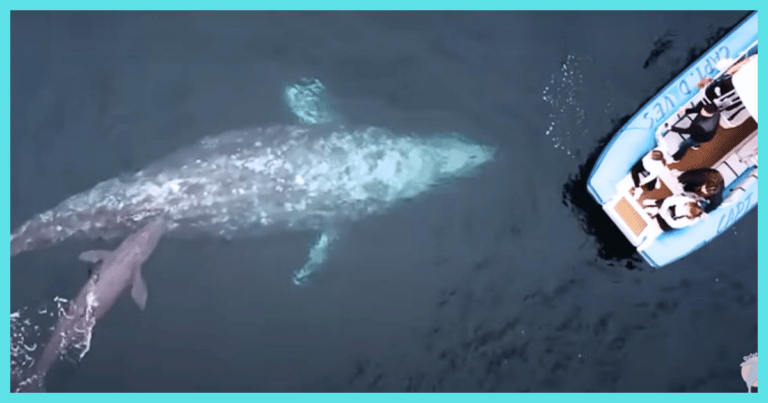
A calm day on a boat watching for whales, was supposed to be a relaxing day for tourists. But it turned into anything but calm when a full-grown adult whale began splashing beside the ship.
At first, the oohs and ahhs were for the amazing sight of a massive whale in the now churning waters. But the happy sounds quickly turned to gasps as blood began to spread around the giant mammal off the coast of Dana Point, Calif.
The tourists, as well as crew, on Captain Dave’s Dolphin & Whale Watching Safari began to fear the worst. Quickly looking for what might be attacking the whale, they instead got to glimpse something that the tour company called ‘a once in a lifetime’ chance ‒ a whale giving birth.
“Many of us thought it may be a shark or predatory event. But no, instead of the end of life, it was the beginning of a new one!” the tour company wrote in a YouTube statement.
In the video posted by the company, Capt. Gary Brighouse said in shock, “This is a first for all of us. We’ve never actually seen it happen,” just moments after witnessing the whale give birth.
A tourist can be heard cooing as the mother whale helped the calf take its first breaths.
Ooh, it’s so cute,” she said. Then as the newborn calf poked its tail out a bit from the water, she added, “it’s so floppy.”
A drone was sent out to film from above. In the footage, the baby whale can be seen lying on its mother, while they nuzzle each other’s faces. The mother was estimated to be between 40-feet to 50-feet long.
Alisa Schulman-Janiger runs the Los Angeles chapter of the American Cetacean Society’s Gray Whale Census and Behavior Project. She told NPR that these early moments show how the calf bonds with its mother.
“The mom is holding the calf up (in the video), supporting it so the calf can rest and actually helping it be able to take a breath.”
Part of the reason for that, she said, is that the calves are born with soft tails that need to firm up over the first 24 hours. Until then, Schulman-Janiger said they need help from their mother to be able to swim forward.
When the calf and mother nuzzle one another’s faces, Schulman-Janiger said that’s typical mammal behavior. “Land mammals smell each other but ocean mammals can’t smell so a lot of their skin (is) very sensitive. That’s why there’s a lot of tactile contact and touching going on.”
We can’t get enough of the newborn calf! 🥰 In this previously unshared footage, the #whale calf swims in circles w/ mom in tow. The little one still hadn’t mastered how to use its flukes for propulsion. It’s learning quickly!
(📷: Matt Stumpf 1.2.23)#danapoint #dronevideo pic.twitter.com/Q2cMZMrUBQ
— CaptDavesWhaleWatching (@DolphinSafari) January 4, 2023
The videos are a momentous find for researchers, Schulman-Janiger said.
“The fact that you can see the blood pool means the calf must have just come out,” she said. “That isn’t something that is seen very often or documented often. In fact, I don’t know if there’s any other video footage of something like that.”
Schulman-Janiger said that the gray whale population is in sharp decline. A large percentage of the whales that appear to be dying off are adult females. “And nobody knows why,” she said.
It’s extraordinarily rare and really, really special for people to be able to share in those first few moments of a young whale’s life. A whale could get to be 50, 60, 80 years old. And this is just the beginning of that calf life.”
Watch below to see the amazing video of the whale and her newborn calf!



